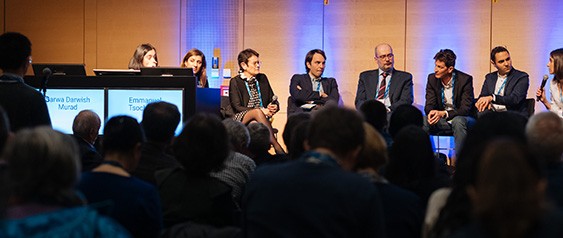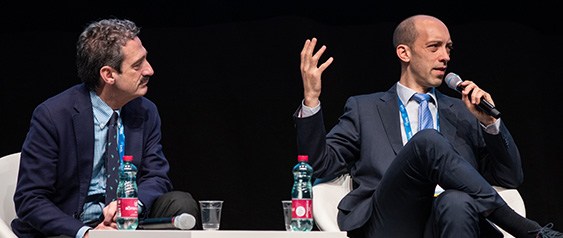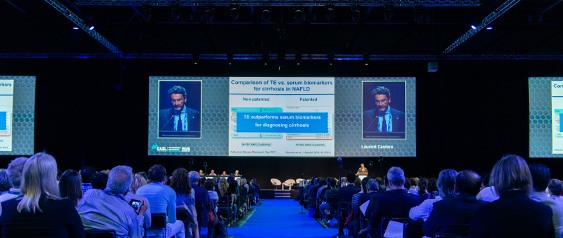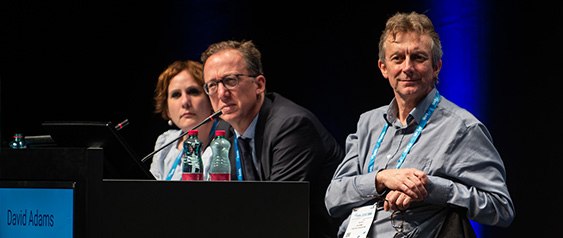
In this issue
Following last year’s hugely successful launch, EASL’s Research Think Tanks are back helping to educate, stimulate and provoke debate on a range of hot topics in hepatology.
International clinicians, scientists and hepatology associates arrived in Vienna today to discuss the latest clinical and scientific advances in the treatment and management of liver disease as the ILC continues its focus on education and cutting-edge research. Also in today’s Daily News, find out what delegates learned from this year’s postgraduate course on end-stage liver disease and basic science seminars on liver immunology and immunotherapy research.



This year’s Research Think Tanks attracted large audiences and generated extensive participation and debate on today’s biggest and most pressing issues in the treatment and management of liver disease.

In the NAFLD think tank, delegates heard updates from EU NAFLD consortia on Europe-wide programmes – including LITMUS and LiverScreen – that aim to develop and validate better biomarkers for NAFLD and establish criteria for screening for liver fibrosis in the general population. In an animated session, the panel and audience debated the arguments for and against population-level screening for NAFLD. Isabel Graupera suggested that, in individuals at high risk of advanced fibrosis or cirrhosis, screening is justified in order to initiate treatment to prevent decompensation. Presenting the endocrinologist’s perspective, Naveed Sattar insisted that we do not have enough data to reliably identify a population in which screening would be practicable and cost effective, estimating that there may be sufficient data to develop a suitable screening algorithm within the next 10 years. Until then, he recommended directing financial investment towards education and policies that promote healthy lifestyle changes. After much further discussion with the audience, ~60% of voting participants agreed that we are not ready for population screening for NAFLD.

The ARLD think tank focused on some of the unique challenges we face in managing this patient population, with one audience member suggesting that hepatologists ‘also need to be psychologists and manage more than just the liver disease’. Despite a lack of antifibrotic therapies, Maja Thiele highlighted excessive drinking as a useful risk factor that is readily accessible to treatment, citing alcohol consumption of >30 g/day as a ‘rule of thumb’ for identifying at-risk patients. There is a relative lack of research in ARLD compared with other liver diseases and Christophe Moreno made an impassioned plea for more high-quality registries to help us assess disease burden, define clinical course, identify risk factors, and determine the effects of interventions. Speakers from the SALVE (Study on Alcohol-related Liver Disease in Europe) Consortium went on to present their work on developing a European registry, as well as an ARLD-specific grading and staging system.


In the first of two think tanks on HCV elimination, the conversation focused on access to care for people who inject drugs (PWID), with a call for expansion of opioid substitution therapy (OST) programmes and integration of HCV treatment into other health services to improve screening and linkage to care in this difficult-to-reach population. Matthew Hickman described how OST programmes can reduce HCV infection rates in PWID by ~50% and cited a recent modelling study in The Lancet that reported scale up of harm reduction services by 40% will be required to achieve the WHO 2030 targets. Opening up the controversial topic of decriminalization, Ricardo Baptista Leite highlighted the example of Portugal, where viral infections have fallen consistently since drug use was legalised in 2001. He also explained that there is a clear need to instigate policy change and collaborate with community-led advocacy groups such as the UNITE network, which uses evidence-based, data-driven campaigning to raise public awareness and engage politicians.

With prisoners among the most at-risk populations for HCV infection, the expert panel discussed the excellent opportunities for HCV intervention in this challenging environment despite significant existing societal and healthcare barriers. Mathematical modelling data suggest that timely treatment with direct-acting antivirals (DAAs), scaling up OST within prisons and maintaining the continuum of care after release have huge potential to reduce the incidence of HCV infection in the wider population. To achieve WHO elimination targets we need high-level co-ordination between national health services and criminal justice authorities to prioritize HCV interventions within prison systems and improve the cascade of care upon release into the community.
Six additional think tanks explored key topics across the spectrum of liver disease, including liver tumours, chronic liver failure, hepatitis B cure, autoimmune and cholestatic liver diseases, factors aggravating portal hypertension, and an EASL take-off event in regenerative hepatology.

Don’t miss

Stuart Forbes from The University of Edinburgh will deliver Thursday’s Translational state of the art lecture: Cell therapy in advanced liver disease in the main plenary from 12:00–12:30

A chance to Meet the experts every day this week and interact with some of the biggest names in hepatology.

Check out the online programme for details of the ILC 2019 Poster Tours, taking place on Thursday, Friday and Saturday.



It was with great pleasure that organizers Frank Lammert, Annalisa Berzigotti, François Durand, and Père Gines welcomed delegates to this year’s postgraduate course, which used interactive, clinical case-based learning to deliver a comprehensive educational programme on end-stage liver disease. Today, in the first three sessions, leading experts in the field discussed new tools in the diagnosis of cirrhosis and portal hypertension, including the advantages and challenges of non-invasive versus invasive tests, how to manage bleeding and thrombosis, and the growing impact of comorbidities when treating patients with cirrhosis. Insights from experts from specialities other than hepatology expanded the scope of the presentations and highlighted the need for a multidiscplinary approach given that organs other than the liver are involved in the progression of chronic liver disease.
Don’t miss the final sessions taking place tomorrow in the Main Plenary



Paving the way for potential future treatment strategies in liver disease, a series of basic science seminars in liver immunology and immunotherapy explored ground breaking research into the microbiome and metabolism, the epigenetic landscape of T-cell exhaustion, the complexities of cellular and molecular hepatic immunology, and expectations for immunotherapy in the treatment of hepatocellular carcinoma. Highlights included:
- A human liver cell atlas used to identify novel immune cell subtypes, which also demonstrated that HCC cells lose their metabolic signature
- Characterization of a fine needle aspirate procedure for obtaining liver leukocytes which may reduce the need for biopsy
- The identification of microbiome oscillations, how they are affected by disrupted Circadian rhythms, and the downstream consequences for diseases including obesity
- How chronic viral infection leads to T-cell exhaustion, and how long-term effects on the epigenetic landscape can lead to reduced T-cell responses even after cure


ILC Insights

What key learnings came out of the Research Think Tank on NAFLD?

What did visitors to the Hepatology arena have to say?

Acknowledgements
‘ILC Daily News’ was supported by grants from: Bayer, Boehringer Ingelheim and Eisai
